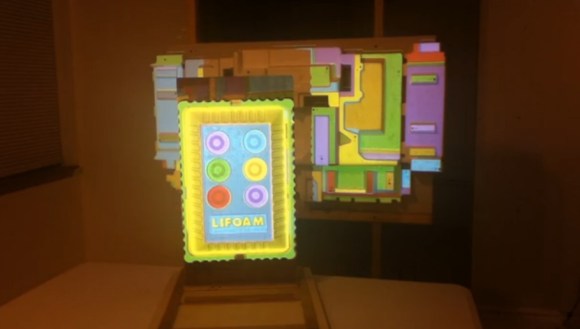
Anyone can grab a projector, plug it in, and fire a movie at the wall. If, however, you want to add some depth to your work–both metaphorical and physical–you’d better start projection mapping. Intricate surfaces like these slabs of styrofoam are excellent candidates for a stunning display, but not without introducing additional complexity to your setup. [Grady] hopes to alleviate some tedium with the TightLight (Warning: “music”).
The video shows the entire mapping process of which the Arduino plays a specific role toward the end. Before tackling any projector calibration, [Grady] needs an accurate 3D model of the projection surface, and boy does it look complicated. Good thing he has a NextEngine 3D laser scanner, which you’ll see lighting the surface red as it cruises along.
Enter the TightLight: essentially 20 CdS photocells hooked up to a Duemilanove, each of which is placed at a previously-marked point on the 3D surface. A quick calibration scan scrolls light from the projector across the X then Y axis, hitting each sensor to determine its exact position. [Grady] then merges the photocell location data with the earlier 3D model using the TouchDesigner platform, and bam: everything lines up and plays nice.














I love this! Great work and very sweet results! (Dont want to join Vimeo just to say this: that music is total crap. Elevator muzak garbled by an auto-glitch plugin… extremely annoying and uncreative)
This is just a video propaganda lacking any details whatsoever.
Another similar project would be Johnny Chung Lees http://www.youtube.com/watch?v=XgrGjJUBF_I&list=TLUbst-_1EU4U
this was actually featured here on hackaday quite a while back. and i think by far seems much simpler than the method above.
[Grady] cites Lee’s work as inspiration for the TightLight in his video comments; this is his attempt to expand on it. I’m not familiar with TouchDesigner, so I cannot comment on what benefits this setup may provide in that context. Still a pretty cool build from scratch, I think.
thank you for that little tidbit. if i had actually watched the video i probably would have seen that.
It’s also way down in the comments, so I wouldn’t have expected anyone to notice! I think I had intended to mention it somewhere in the writeup, but it slipped my mind. It sounds like you may have been fortunate enough not to hear the video’s music, though =x
Obviously you don’t need a 3000 USD 3D scanner, just a 3D modell and a bigger CNC, but building stuff out of cubes is a bit cheaper. :-/
I wonder how fast, and nice looking, you can do that TightLight scanning if you use other patterns.
TL;DW, but isn’t the traditional way to do this to project linear patterns on the surface, take video of the projection, and use that to come up with a transform to distort the 2d image to the surface?